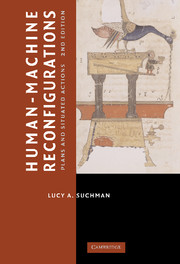Book contents
- Frontmatter
- Contents
- Acknowledgments
- Preface to the 2nd Edition
- Introduction
- 1 Readings and Responses
- 2 Preface to the 1st Edition
- 3 Introduction to the 1st Edition
- 4 Interactive Artifacts
- 5 Plans
- 6 Situated Actions
- 7 Communicative Resources
- 8 Case and Methods
- 9 Human–Machine Communication
- 10 Conclusion to the 1st Edition
- 11 Plans, Scripts, and Other Ordering Devices
- 12 Agencies at the Interface
- 13 Figuring the Human in AI and Robotics
- 14 Demystifications and Reenchantments of the Humanlike Machine
- 15 Reconfigurations
- References
- Index
1 - Readings and Responses
Published online by Cambridge University Press: 05 June 2012
- Frontmatter
- Contents
- Acknowledgments
- Preface to the 2nd Edition
- Introduction
- 1 Readings and Responses
- 2 Preface to the 1st Edition
- 3 Introduction to the 1st Edition
- 4 Interactive Artifacts
- 5 Plans
- 6 Situated Actions
- 7 Communicative Resources
- 8 Case and Methods
- 9 Human–Machine Communication
- 10 Conclusion to the 1st Edition
- 11 Plans, Scripts, and Other Ordering Devices
- 12 Agencies at the Interface
- 13 Figuring the Human in AI and Robotics
- 14 Demystifications and Reenchantments of the Humanlike Machine
- 15 Reconfigurations
- References
- Index
Summary
This chapter provides a synopsis and some contextualization of the analysis offered in the original edition of Plans and Situated Actions (P&SA), published in 1987, followed by my reflections on the reception and readings of that text. My engagement with the question of human–machine interaction, from which the book arose, began in 1979, when I arrived at PARC as a doctoral student interested in a critical anthropology of contemporary American institutions and with a background as well in ethnomethodology and interaction analysis. My more specific interest in the question of interactivity at the interface began when I became intrigued by an effort among my colleagues to design an interactive interface to a particular machine. The project was initiated in response to a delegation of Xerox customer service managers, who traveled to PARC from Xerox's primary product development site in Rochester, New York, to report on a problem with the machine and to enlist research advice in its solution. The machine was a relatively large, feature-rich photocopier that had just been “launched,” mainly as a placeholder to establish the company's presence in a particular market niche that was under threat from other, competitor, companies. The machine was advertised with a figure dressed in the white lab coat of the scientist/engineer but reassuring the viewer that all that was required to activate the machine's extensive functionality was to “press the green [start] button” (see Fig. 1.1).
- Type
- Chapter
- Information
- Human-Machine ReconfigurationsPlans and Situated Actions, pp. 8 - 23Publisher: Cambridge University PressPrint publication year: 2006



